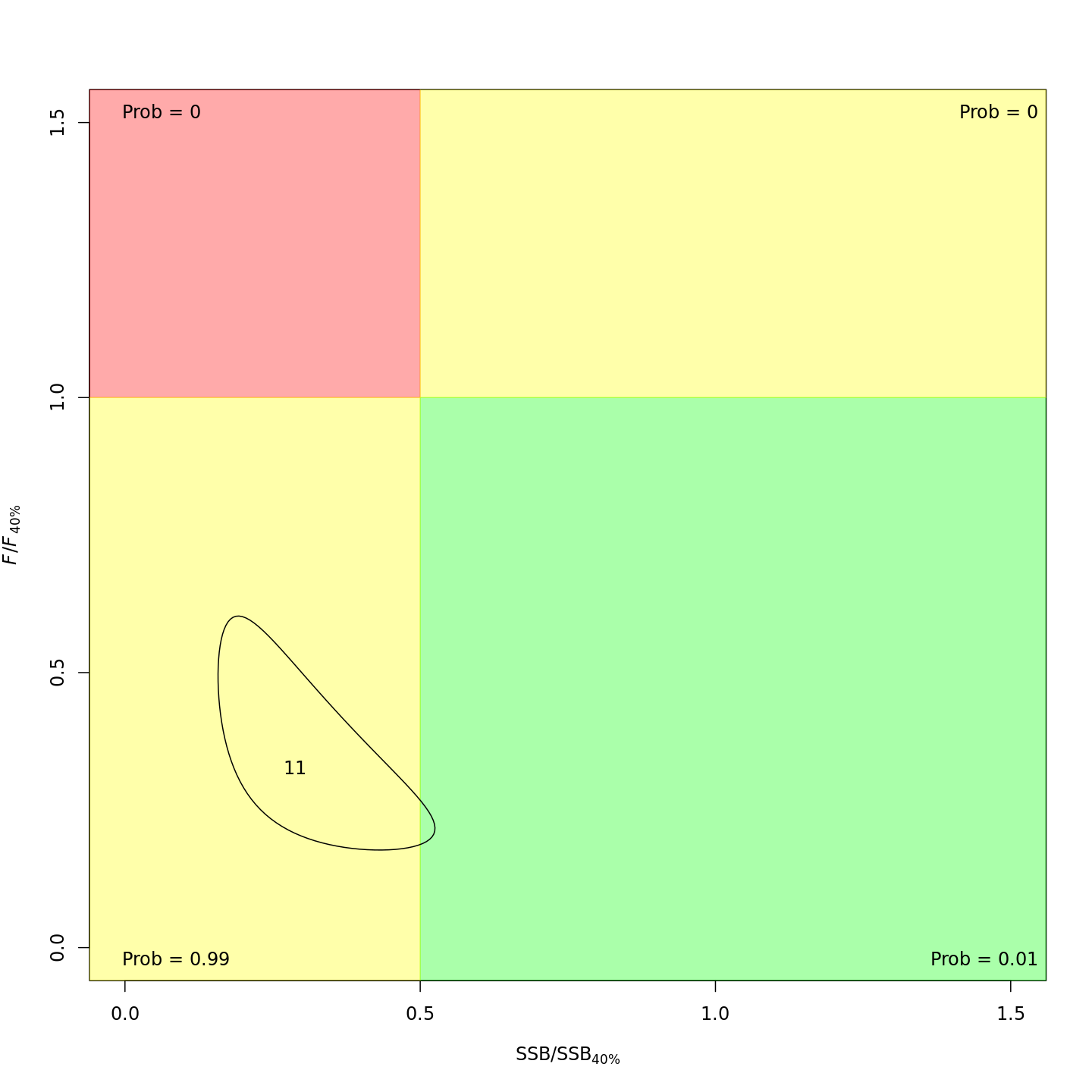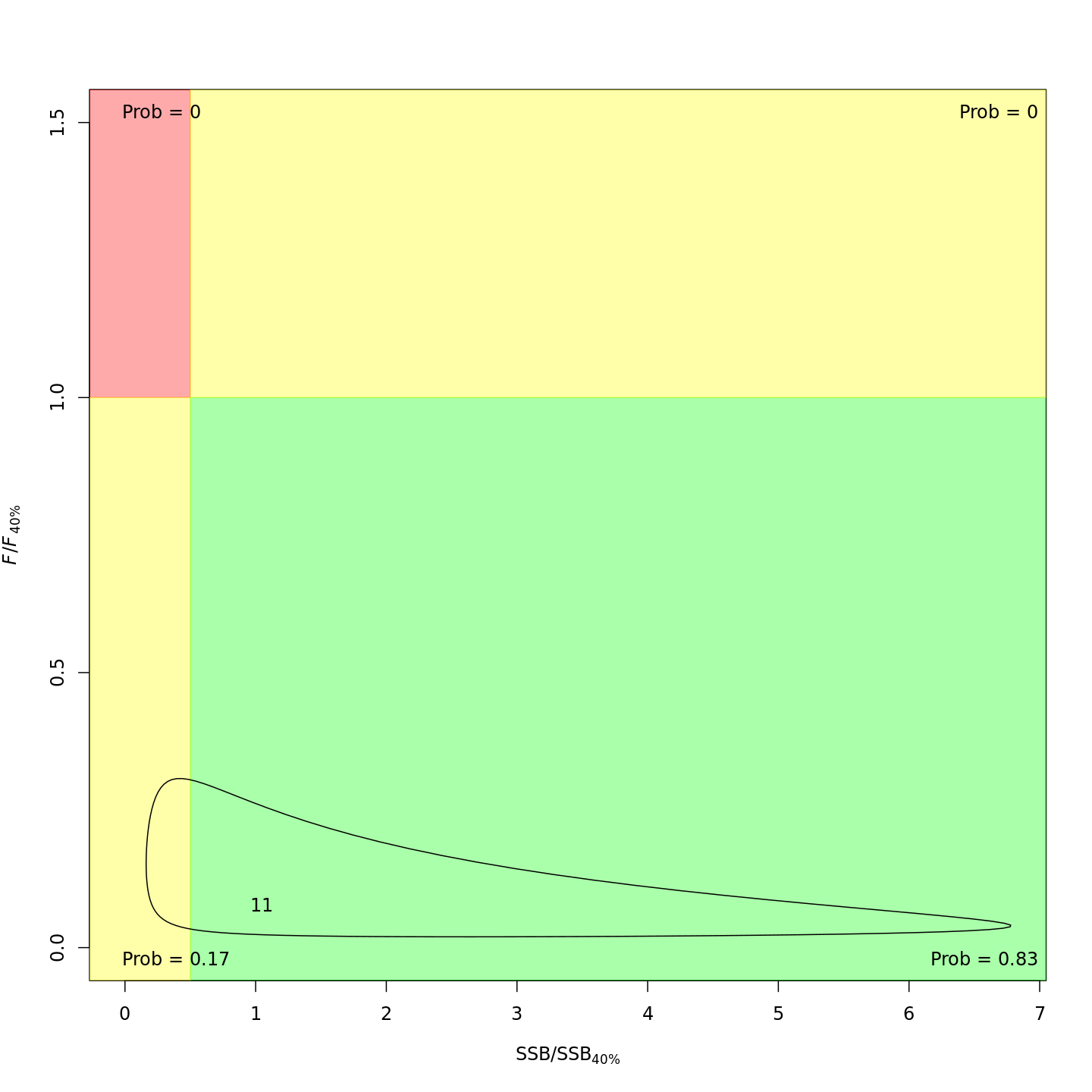Ex 5: Time-varying natural mortality linked to the Gulf Stream Index
Source:vignettes/ex05_GSI_M.Rmd
ex05_GSI_M.RmdIn this vignette we walk through an example using the
wham (WHAM = Woods Hole Assessment Model) package to run a
state-space age-structured stock assessment model. WHAM is a
generalization of code written for Miller et al. (2016)
and Xu et
al. (2018), and in this example we apply WHAM to the same stock,
Southern New England / Mid-Atlantic Yellowtail Flounder.
This is the 5th WHAM example, which builds off example 2 (also available as an R script :
- full state-space model (numbers-at-age are random effects for all
ages,
NAA_re = list(sigma='rec+1',cor='iid')) - logistic normal age compositions, pooling zero observations with
adjacent ages (
age_comp = "logistic-normal-pool0") - random-about-mean recruitment (
recruit_model = 2) - 5 indices
- fit to 1973-2011 data
We assume you already have wham installed. If not, see
the Introduction. The
simpler 1st example, without environmental effects or time-varying \(M\), is available as a R
script and vignette.
In example 5, we demonstrate how to specify and run WHAM with the following options for natural mortality:
- not estimated (fixed at input values)
- one value, \(M\)
- age-specific, \(M_a\) (independent)
- function of weight-at-age, \(M_{y,a} = \mu_M * W_{y,a}^b\)
- AR1 deviations by age (random effects), \(M_{y,a} = \mu_M + \delta_a \quad\mathrm{and}\quad \delta_a \sim \mathcal{N} (\rho_a \delta_{a-1}, \sigma^2_M)\)
- AR1 deviations by year (random effects), \(M_{y,a} = \mu_M + \delta_y \quad\mathrm{and}\quad \delta_y \sim \mathcal{N} (\rho_y \delta_{y-1}, \sigma^2_M)\)
- 2D AR1 deviations by age and year (random effects), \(M_{y,a} = M_a + \delta_{y,a} \quad\mathrm{and}\quad \delta_{y,a} \sim \mathcal{N}(0,\Sigma)\)
We also demonstrate alternate specifications for the link between \(M\) and an environmental covariate, the Gulf Stream Index (GSI), as in O’Leary et al. (2019):
- none
- linear (in log-space), \(M_{y,a} = e^{\mathrm{log}\mu_M + \beta_1 E_y}\)
- quadratic (in log-space), \(M_{y,a} = e^{\mathrm{log}\mu_M + \beta_1 E_y + \beta_2 E^2_y}\)
Note that you can specify more than one of the above effects on \(M\), although the model may not be estimable. For example, the most complex model with weight-at-age, 2D AR1 age- and year-deviations, and a quadratic environmental effect: \(M_{y,a} = e^{\mathrm{log}\mu_M + b W_{y,a} + \beta_1 E_y + \beta_2 E^2_y + \delta_{y,a}}\).
1. Load data
Open R and load wham and other useful packages:
For a clean, runnable .R script, look at
ex5_M_GSI.R in the example_scripts folder of
the wham package. You can run this entire example script
with:
wham.dir <- find.package("wham")
source(file.path(wham.dir, "example_scripts", "ex5_M_GSI.R"))Let’s create a directory for this analysis:
# choose a location to save output, otherwise will be saved in working directory
write.dir <- "choose/where/to/save/output" # need to change e.g., tempdir(check=TRUE)
dir.create(write.dir)
setwd(write.dir)We need the same ASAP data file as in example
2, and the environmental covariate (Gulf Stream Index, GSI). Read in
ex2_SNEMAYT.dat and GSI.csv:
asap3 <- read_asap3_dat(file.path(wham.dir,"extdata","ex2_SNEMAYT.dat"))
env.dat <- read.csv(file.path(wham.dir,"extdata","GSI.csv"), header=T)
head(env.dat)The GSI does not have a standard error estimate, either for each yearly observation or one overall value. In such a case, WHAM can estimate the observation error for the environmental covariate, either as one overall value, \(\sigma_E\), or yearly values as random effects, \(\mathrm{log}\sigma_{E_y} \sim \mathcal{N}(\mathrm{log}\sigma_E, \sigma^2_{\sigma_E})\). In this example we choose the simpler option and estimate one observation error parameter, shared across years.
2. Specify models
Now we specify 14 models with different options for natural mortality:
Ecov_how <- paste0(
c("none",rep("",2), rep("none", 9), rep("", 2)),
c("", rep("lag-0-",2), rep("",9), rep("lag-0-",2)),
c("", "linear", "poly-2", rep("",9), "linear", "poly-2"))
mean_model <- c(rep("fixed-M",6), "estimate-M", "weight-at-age", rep("estimate-M",6))
age_specific <- c(rep(NA,6),TRUE, NA, rep(FALSE, 6))
df.mods <- data.frame(M_model = c(rep("---",6),"age-specific","weight-at-age",rep("constant",6)),
mean_model = mean_model,
age_specific = age_specific,
M_re = c(rep("none",3),"ar1_a","ar1_y","ar1_ay",rep("none",3),"ar1_a", "ar1_y",rep("ar1_ay",3)),
Ecov_process = rep("ar1",14),
Ecov_how = Ecov_how, stringsAsFactors=FALSE)
n.mods <- dim(df.mods)[1]
df.mods$Model <- paste0("m",1:n.mods)
df.mods <- df.mods |> select(Model, everything()) # moves Model to first colLook at the model table:
df.mods
#> Model M_model mean_model age_specific M_re Ecov_process
#> 1 m1 --- fixed-M NA none ar1
#> 2 m2 --- fixed-M NA none ar1
#> 3 m3 --- fixed-M NA none ar1
#> 4 m4 --- fixed-M NA ar1_a ar1
#> 5 m5 --- fixed-M NA ar1_y ar1
#> 6 m6 --- fixed-M NA ar1_ay ar1
#> 7 m7 age-specific estimate-M TRUE none ar1
#> 8 m8 weight-at-age weight-at-age NA none ar1
#> 9 m9 constant estimate-M FALSE none ar1
#> 10 m10 constant estimate-M FALSE ar1_a ar1
#> 11 m11 constant estimate-M FALSE ar1_y ar1
#> 12 m12 constant estimate-M FALSE ar1_ay ar1
#> 13 m13 constant estimate-M FALSE ar1_ay ar1
#> 14 m14 constant estimate-M FALSE ar1_ay ar1
#> Ecov_how
#> 1 none
#> 2 lag-0-linear
#> 3 lag-0-poly-2
#> 4 none
#> 5 none
#> 6 none
#> 7 none
#> 8 none
#> 9 none
#> 10 none
#> 11 none
#> 12 none
#> 13 lag-0-linear
#> 14 lag-0-poly-2The first 6 models fix mean natural mortality rates. Some of these models assume age and or year varying random effects or effects of GSI on M. Model 7 estimates age-specific M as fixed effects and Model 8 estimates M as a function of weight at age. Models 9-14 make similar assumptions to models 1-6, but a constant mean M parameter (across age and time) is estimated.
3. Natural mortality options
We specify the options for modeling natural mortality by including an
optional list argument, M, to the
prepare_wham_input() function (see the
prepare_wham_input() and set_M() help pages).
M specifies estimation options and can overwrite M-at-age
values specified in the ASAP data file. By default (i.e. M
is NULL or not included), the M-at-age matrix from the ASAP
data file is used (M fixed, not estimated). M is a list
that includes following entries relevant here:
-
$mean_model: Natural mortality model options.-
"constant": estimate a single \(M\), shared across all ages and years. -
"age-specific": estimate \(M_a\) independent for each age, shared across years. -
"weight-at-age": estimate \(M\) as a function of weight-at-age, \(M_{y,a} = \mu_M * W_{y,a}^b\), as in Lorenzen (1996) and Miller & Hyun (2018).
-
-
$re_model: Time- and age-varying random effects on \(M\).-
"none": \(M\) constant in time and across ages (default). -
"iid_a": \(M\) varies by age, but uncorrelated and constant over years. -
"iid_y": \(M\) varies by year, but uncorrelated and constant over age. -
"iid_ay": \(M\) varies by year and age, but uncorrelated. -
"ar1_a": \(M\) correlated by age (AR1), constant in time. -
"ar1_y": \(M\) correlated by year (AR1), constant by age. -
"ar1_ay": \(M\) correlated by year and age (2D AR1), as in Cadigan (2016).
-
$initial_means: an array of initial/mean M parameters (n_stocks x n_regions x n_ages). IfNULL, initial mean M-at-age values are taken from the first row of the MAA matrix in the ASAP data file(s).$means_map: an array of integers (n_stocks x n_regions x n_ages) of that distinguishes which mean parameters to estimate and whether any should have the same value. In all models we have 1 stock and 1 region and 6 ages. So to estimate different M for each age we set:$means_map = array(1:6, dim = c(1,1,6)). IfNULL, \(M\) at all ages is fixed atM$initial_means(if notNULL) or row 1 of the MAA matrix from the ASAP file(s) (ifM$initial_means = NULL).
For example, to fit model m1, fix \(M_a\) at values in ASAP file:
M <- NULL # or simply leave out of call to prepare_wham_inputTo fit model m9, estimate one \(M\), constant by year and age:
To fit model m12 where we estimate a mean \(M\) parameter and 2DAR1 deviations by year
and age:
M <- list(model="estimate-M", means_map = array(1, dim = c(1,1,asap3[[1]]$dat$n_ages)), re_model="ar1_ay")To fit model m11, use the \(M_a\) values specified in the ASAP file,
but with 2D AR1 deviations as in Cadigan
(2016):
4. Linking M to an environmental covariate (GSI)
As described in example
2, the environmental covariate options are fed to
prepare_wham_input() as a list, ecov. This
example differs from example 2 in that:
- We will estimate the observation error for the GSI (one overall
value for all years):
$logsigma = "est_1". The other option is"est_re"to allow the GSI observation error to have yearly fluctuations (random effects). The Cold Pool Index in example 2 had yearly observation errors given. - We will assume GSI affects \(M\) rather than recruitment.
- We will assume a lag of 0 for the effect of GSI on \(M\): GSI in year t affects \(M\) in year t, instead of year t+1.
- We will consider models with and without the effect of GSI on \(M\), but keep the state-space model for GSI in the model to allow AIC comparisons.
- We will consider both linear and quadratic effects of GSI on \(M\). WHAM includes a function to calculate
orthogonal polynomials in TMB, akin to the
poly()function in R.
For example, the ecov list for model m3
with a quadratic GSI-M effect:
# example for model m3
ecov <- list(
label = "GSI",
mean = as.matrix(env.dat$GSI),
logsigma = 'est_1', # estimate obs sigma, 1 value shared across years
year = env.dat$year,
use_obs = matrix(1, ncol=1, nrow=dim(env.dat)[1]), # use all obs (=1)
lag = 0, # GSI in year t affects M in same year
process_model = "ar1", # GSI modeled as AR1 (random walk would be "rw")
M_how = array("lag-0-poly-2",c(1,1,6,1))) # n_Ecov x n_stocks x n_ages x n_regionsNote that you can set ecov = NULL to fit the model
without environmental covariate data, but here we fit the
ecov data even for models without GSI effect on \(M\) (m1, m4-12)
so that we can compare them via AIC (need to have the same data in the
likelihood). We accomplish this by setting
ecov$M_how = array("none",c(1,1,6,1)) and
ecov$process_model = "ar1".
5. Run all models
All models use the same options for recruitment (random-about-mean, no stock-recruit function) and selectivity (logistic, with parameters fixed for indices 4 and 5).
mods <- list()
for(m in 1:n.mods){
ecov <- list(
label = "GSI",
mean = as.matrix(env.dat$GSI),
logsigma = 'est_1', # estimate obs sigma, 1 value shared across years
year = env.dat$year,
use_obs = matrix(1, ncol=1, nrow=dim(env.dat)[1]), # use all obs (=1)
process_model = df.mods$Ecov_process[m], # "rw" or "ar1"
M_how = array(df.mods$Ecov_how[m],c(1,1,asap3[[1]]$dat$n_ages,1))) # n_Ecov x n_stocks x n_ages x n_regions
mean_map <- NULL
if(df.mods$mean_model[m] == "estimate-M"){
if(df.mods$age_specific[m]) mean_map[1,1,] <- 1:asap3[[1]]$dat$n_ages
else mean_map[1,1,] <- 1
}
M <- list(
mean_model = df.mods$mean_model[m],
re_model = matrix(df.mods$M_re[m], 1,1),
means_map = mean_map
)
if(df.mods$mean_model[m] == "estimate-M" & !df.mods$age_specific[m]) M$initial_means = array(0.28, c(1,1,asap3[[1]]$dat$n_ages)) #n_stocks x n_regions x n_ages
input <- prepare_wham_input(asap3, recruit_model = 2,
model_name = paste0("m",m,": ", df.mods$mean_model[m]," + GSI link: ",df.mods$Ecov_how[m]," + M RE: ", df.mods$M_re[m]),
ecov = ecov,
selectivity=list(model=rep("logistic",6),
initial_pars=c(rep(list(c(3,3)),4), list(c(1.5,0.1), c(1.5,0.1))),
fix_pars=c(rep(list(NULL),4), list(1:2, 1:2))),
NAA_re = list(sigma='rec+1',cor='iid'),
M=M,
age_comp = "logistic-normal-pool0")
# Fit model
mods[[m]] <- fit_wham(input, do.retro=T, do.osa=F) # turn off OSA residuals to save time
# Save model
saveRDS(mod[[m]], file=paste0(df.mods$Model[m],".rds"))
# If desired, plot output in new subfolder
# plot_wham_output(mod=mod, dir.main=file.path(getwd(),df.mods$Model[m]), out.type='html')
# If desired, do projections
# mod_proj <- project_wham(mod)
# saveRDS(mod_proj, file=paste0(df.mods$Model[m],"_proj.rds"))
}6. Compare models
Get model convergence and stats.
opt_conv = 1-sapply(mods, function(x) x$opt$convergence)
ok_sdrep = sapply(mods, function(x) if(x$na_sdrep==FALSE & !is.na(x$na_sdrep)) 1 else 0)
df.mods$conv <- as.logical(opt_conv)
df.mods$pdHess <- as.logical(ok_sdrep)Only calculate AIC and Mohn’s rho for converged models.
df.mods$runtime <- sapply(mods, function(x) x$runtime)
df.mods$NLL <- sapply(mods, function(x) round(x$opt$objective,3))
is_conv <- df.mods$conv & df.mods$pdHess
which(is_conv) # 1, 2, 5, 8, 9, 11, 12
mods2 <- mods[is_conv]
#mods2[not_conv] <- NULL
df.aic.tmp <- as.data.frame(compare_wham_models(mods2, table.opts=list(sort=FALSE, calc.rho=TRUE))$tab)
df.aic <- df.aic.tmp[FALSE,]
ct = 1
for(i in 1:n.mods){
if(!is_conv[i]){
df.aic[i,] <- rep(NA,5)
} else {
df.aic[i,] <- df.aic.tmp[ct,]
ct <- ct + 1
}
}
df.aic[,1:2] <- format(round(df.aic[,1:2], 1), nsmall=1)
df.aic[,3:5] <- format(round(df.aic[,3:5], 3), nsmall=3)
df.aic[grep("NA",df.aic$dAIC),] <- "---"
df.mods <- cbind(df.mods, df.aic)
rownames(df.mods) <- NULLLook at results table.
df.mods7. Results
In the table, we have highlighted in gray models which converged and
successfully inverted the Hessian to produce SE estimates for all (fixed
effect) parameters. WHAM stores this information in
mod$na_sdrep (should be FALSE),
mod$sdrep$pdHess (should be TRUE), and
mod$opt$convergence (should be 0). See
stats::nlminb() and TMB::sdreport() for
details.
Model m12 (estimate mean \(M\) and 2D AR1 deviations by year and age,
no GSI effect) had the lowest AIC among converged models and was
overwhelmingly supported relative to the other models
(bold in table below). The retrospective patterns in
SSB and \(F\) were also negligble
compared to other models as measured by Mohn’s \(\rho\).
| Model | M mean model | M RE model | GSI model | GSI link | Converged | Pos def Hessian |
Runtime
(mi
|
)| N | L|dAI | |AIC | |\(\rho_{R} </th> <th style="text-align:left;"> |\)_{SSB} | |$_{} | |
|---|---|---|---|---|---|---|---|---|---|---|---|---|---|
| m1 | — | none | ar1 | none | TRUE | TRUE | 0.82 | -813.858 | 37.1 | -1489.7 | 0.259 | 0.117 | -0.145 |
| m2 | — | none | ar1 | lag-0-linear | TRUE | TRUE | 0.70 | -819.584 | 27.6 | -1499.2 | 0.400 | 0.150 | -0.164 |
| m3 | — | none | ar1 | lag-0-poly-2 | TRUE | FALSE | 2.68 | -820.307 | — | — | — | — | — |
| m4 | — | ar1_a | ar1 | none | TRUE | FALSE | 0.84 | -828.322 | — | — | — | — | — |
| m5 | — | ar1_y | ar1 | none | TRUE | TRUE | 0.75 | -821.393 | 26.0 | -1500.8 | 0.704 | 0.128 | -0.133 |
| m6 | — | ar1_ay | ar1 | none | FALSE | FALSE | 0.39 | -813.968 | — | — | — | — | — |
| m7 | age-specific | none | ar1 | none | TRUE | FALSE | 0.78 | -837.559 | — | — | — | — | — |
| m8 | weight-at-age | none | ar1 | none | TRUE | TRUE | 0.57 | -825.020 | 18.8 | -1508.0 | 0.725 | 0.140 | -0.144 |
| m9 | constant | none | ar1 | none | TRUE | TRUE | 0.58 | -825.015 | 16.8 | -1510.0 | 0.544 | 0.129 | -0.141 |
| m10 | constant | ar1_a | ar1 | none | TRUE | FALSE | 1.02 | -829.109 | — | — | — | — | — |
| m11 | constant | ar1_y | ar1 | none | TRUE | TRUE | 0.74 | -825.399 | 20.0 | -1506.8 | 1.186 | 0.414 | -0.298 |
| m12 | constant | ar1_ay | ar1 | none | TRUE | TRUE | 0.85 | -836.408 | 0.0 | -1526.8 | 0.312 | 0.006 | -0.044 |
| m13 | constant | ar1_ay | ar1 | lag-0-linear | FALSE | FALSE | 0.54 | -845.739 | — | — | — | — | — |
| m14 | constant | ar1_ay | ar1 | lag-0-poly-2 | FALSE | FALSE | 2.06 | -845.339 | — | — | — | — | — |
Estimated M
- Models allowed to estimate mean \(M\) increased \(M\) (
m7-m14) compared to the fixed values in modelsm1-m6(more green/yellow than blue). - Models that estimated \(M_a\)
(
m4,m7,m10) had highest \(M_a\) for ages 4-5. - Models that estimated \(M_y\)
(
m5andm11) had higher \(M_y\) in the early 1990s and early 2000s. - Models with GSI effects and random effects deviations in M did not converge.
Model m6 left \(M_a\)
fixed at the values from the ASAP data file (as in m1) and
estimated 2D AR1 deviations around these mean \(M_a\), but this model did not converge.
This is how \(M\) was modeled in Cadigan
(2016). Model m8 that assumed M as a function of weight
at age estimated essentially no effect so that M was constant and a
negative log likelihood essentially the same as model m9
that made the simpler assumption of a constant M estimated. Below is a
plot of \(M\) by age (y-axis) and year
(x-axis) for all models. Models with a positive definite Hessian are
solid, and models with non-positive definite Hessian are pale.
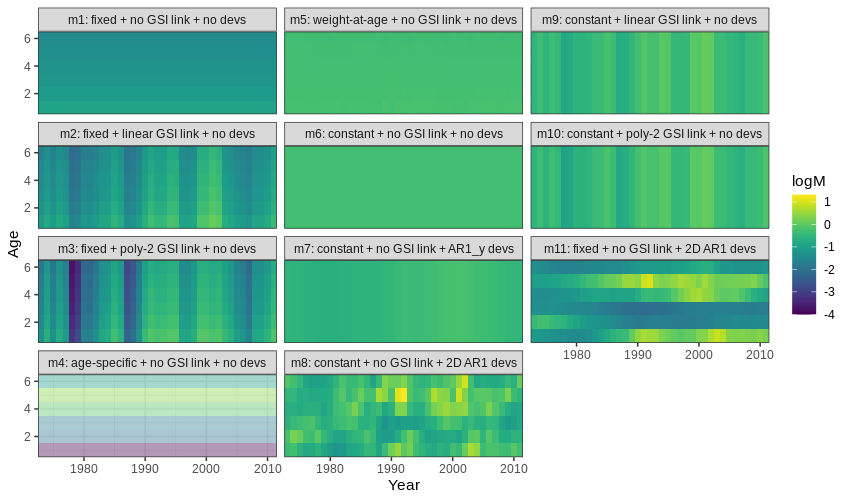
Natural mortality by age (y-axis) and year (x-axis) for all models.
Retrospective patterns
Compared to m1, the retrospective pattern for
m12 was slightly worse for recruitment (m12
0.31, m1 0.26) but improved for SSB (m8 0.01,
m1 0.11) and F (m8 -0.04, m1
-0.15). Compare the retrospective patterns of numbers-at-age, SSB, and F
for models m1 (left, fixed \(M_a\)) and m12 (right,
estimated \(M\) + 2D AR1
deviations).
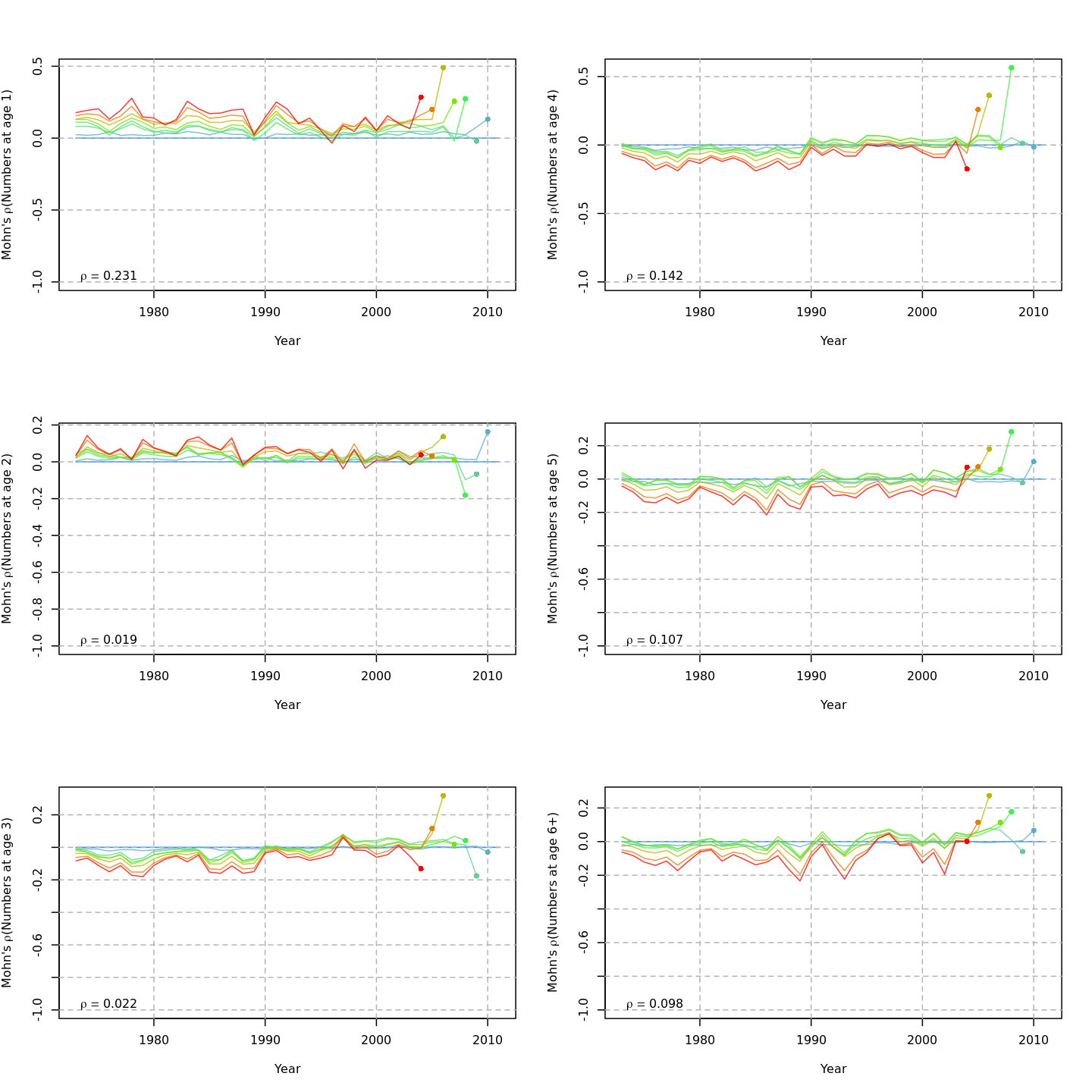
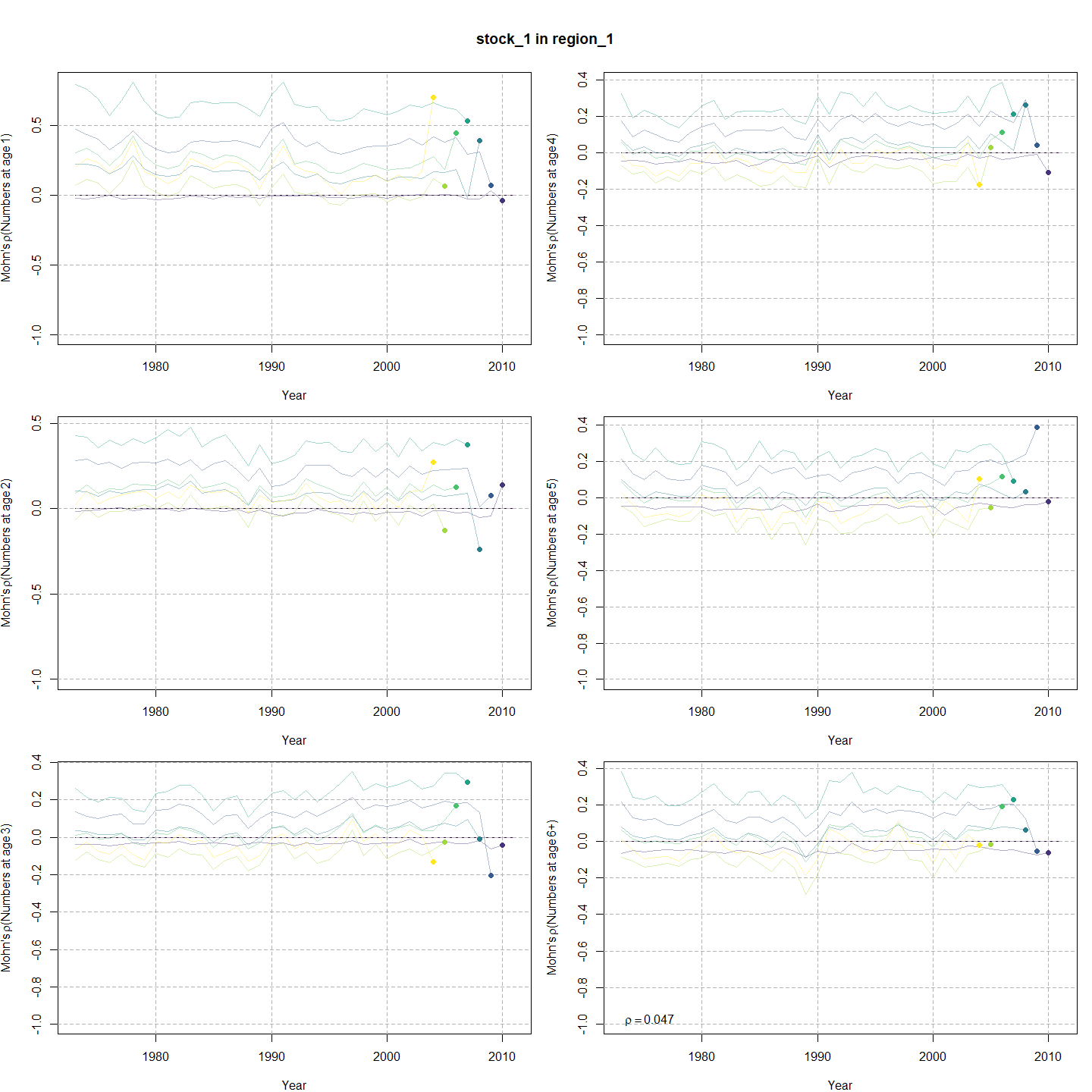
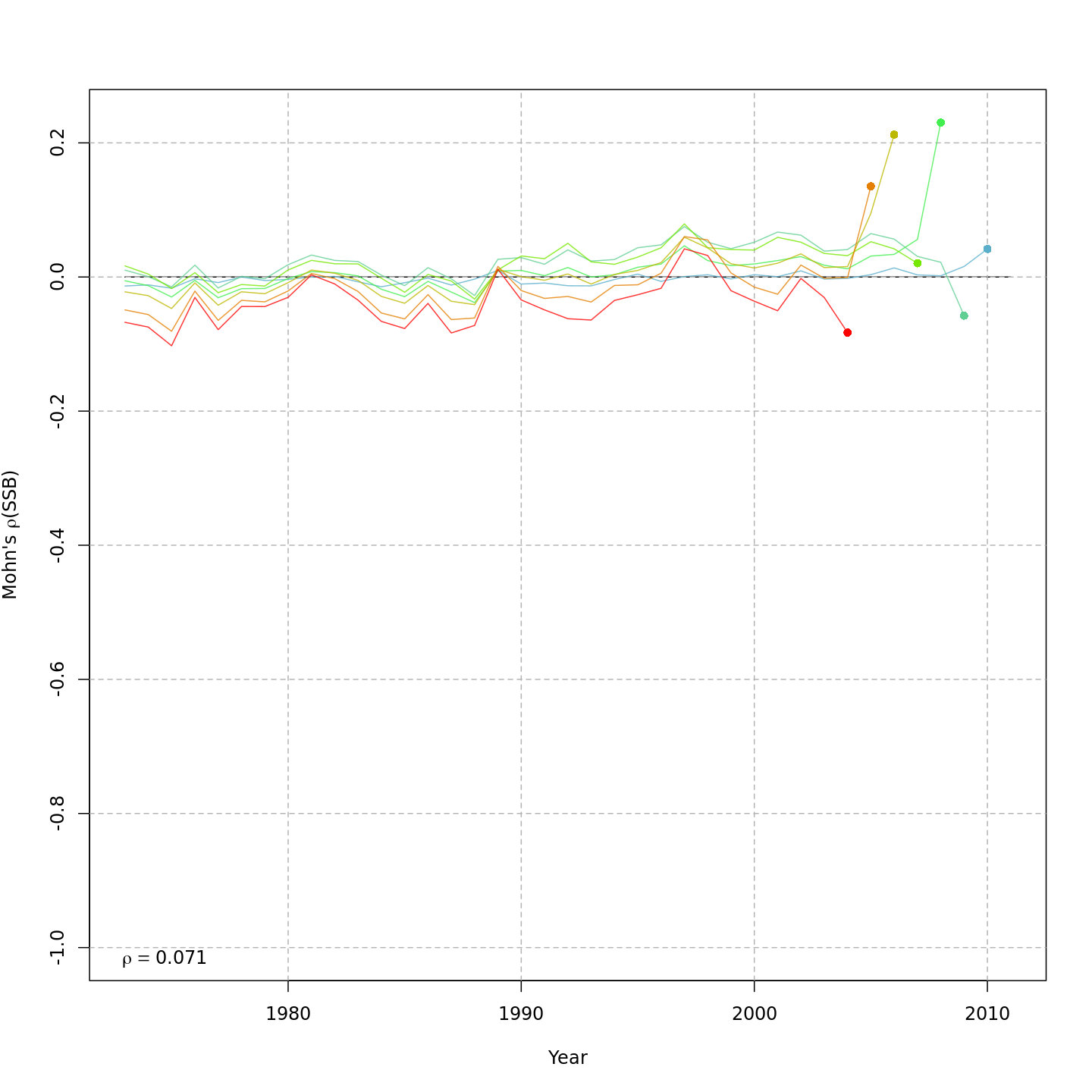
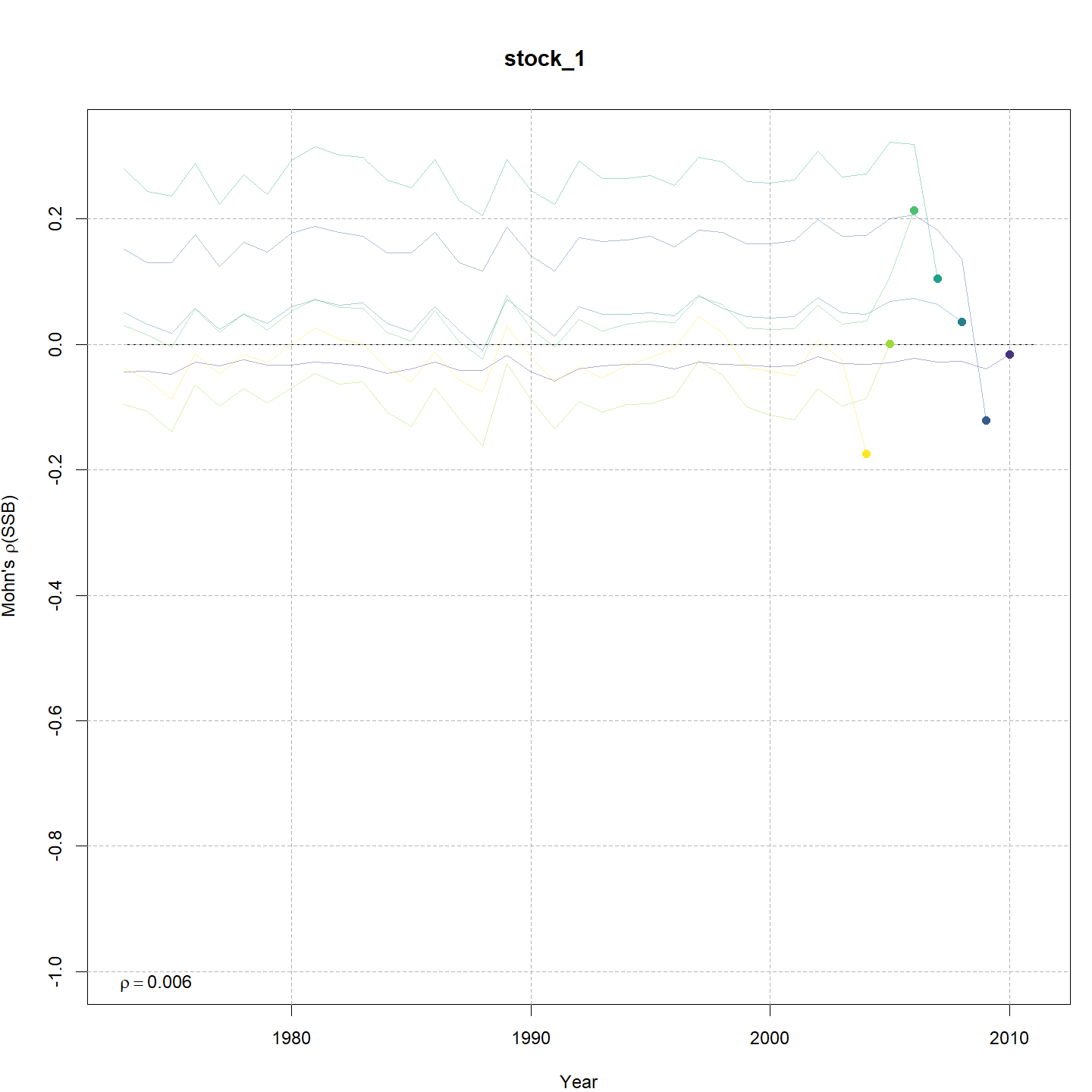
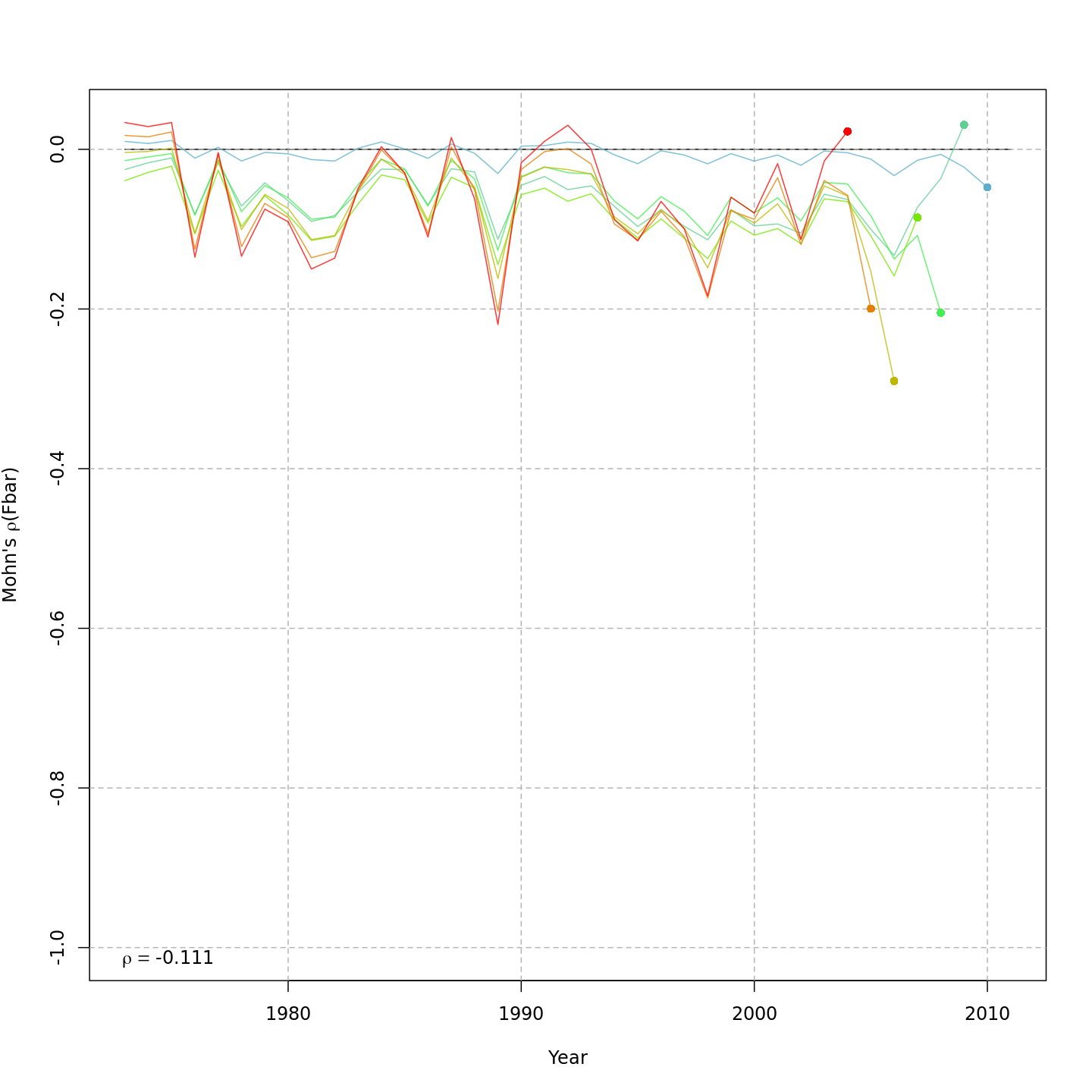
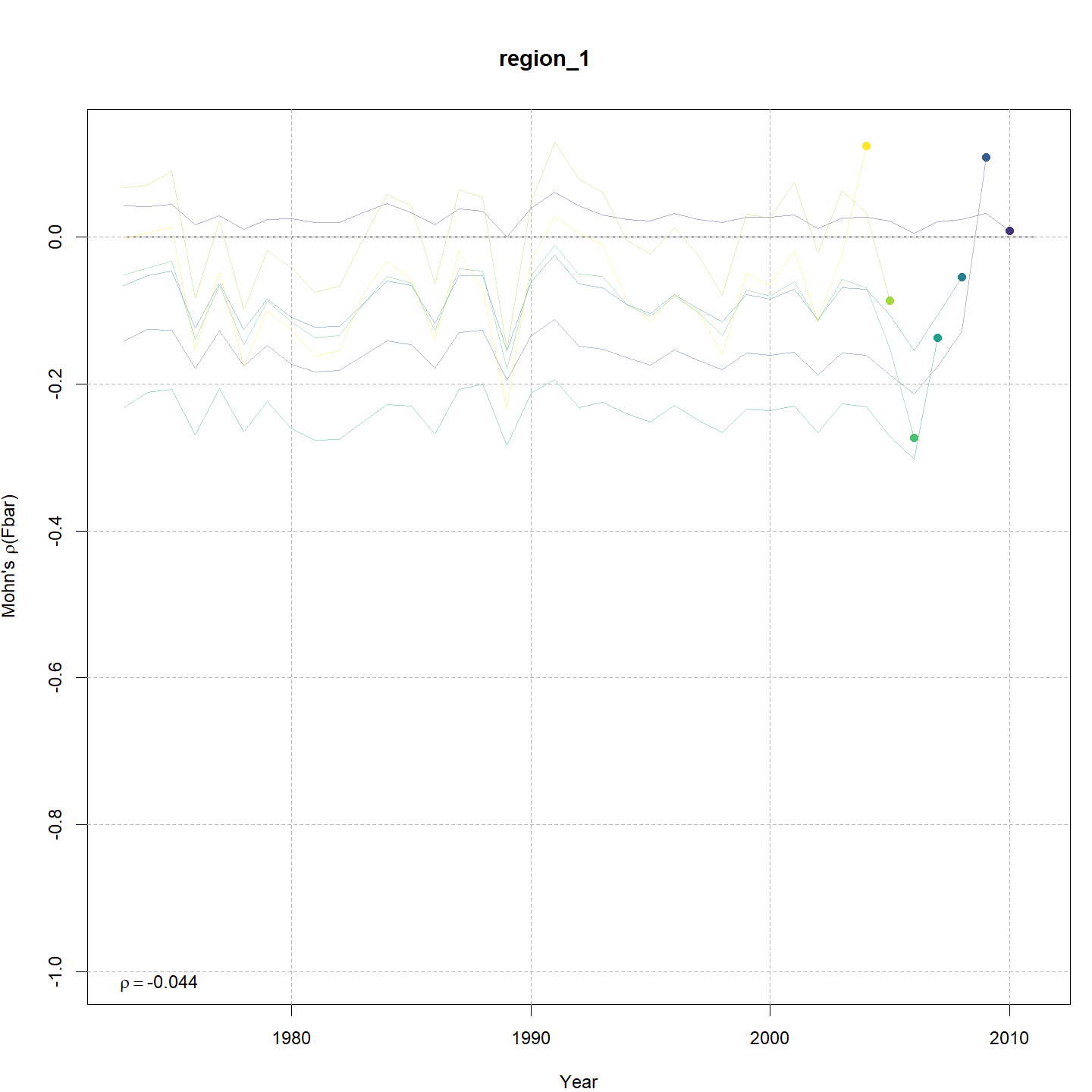
Stock status
Compared to m1 (left), m12 (right)
estimated SPR-based reference points were more uncertain due to
estimation of M rather than an assumed value. Model m12
estimates of \(F_{40\%SPR}\) (middle)
and yield at \(F_{40\%SPR}\) (top) were
higher, whereas estimates of SSB at \(F_{40\%SPR}\) were generally lower.
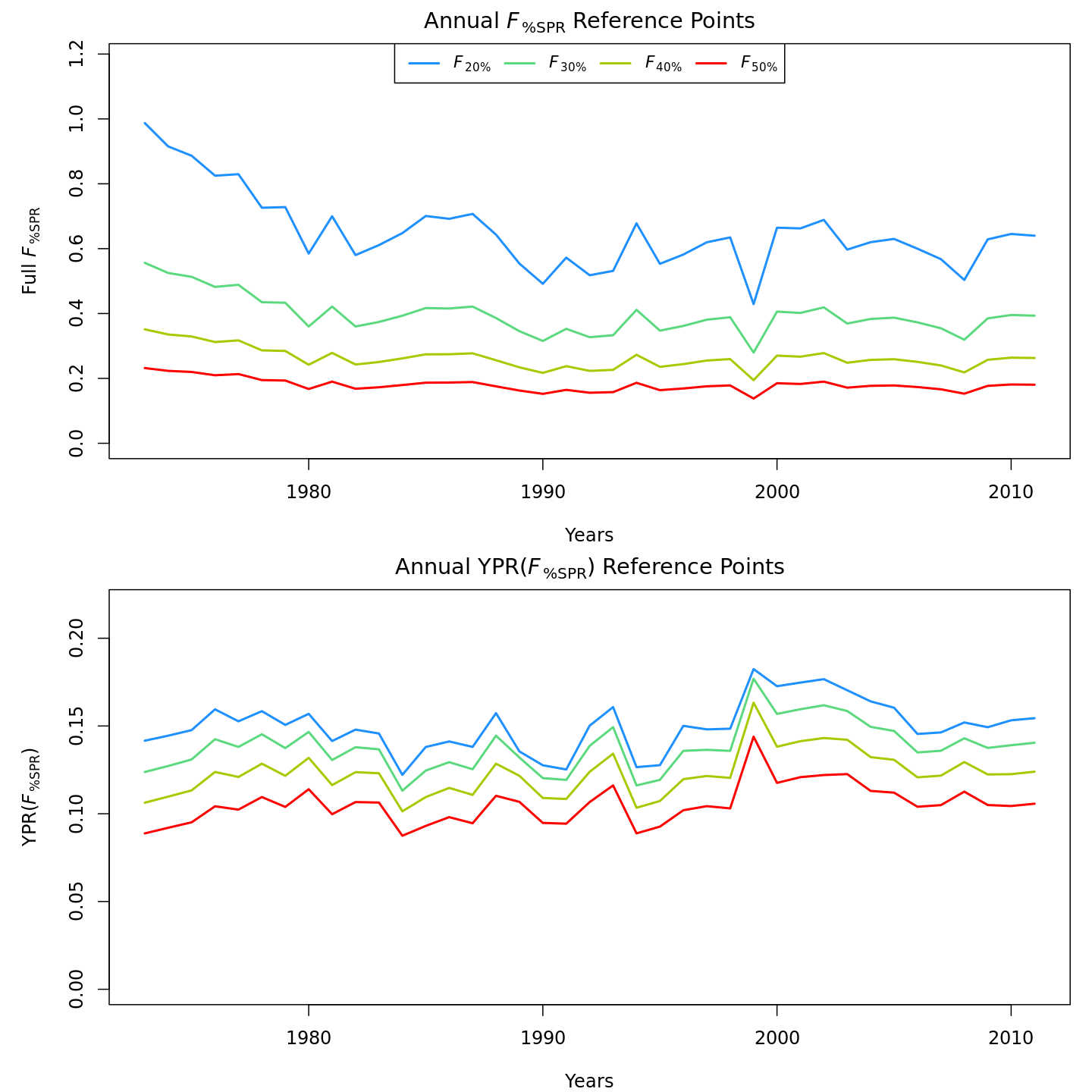

Compared to m1 (left), m12 (right)
estimated higher M and higher SSB – a much rosier picture of
the stock status through time.
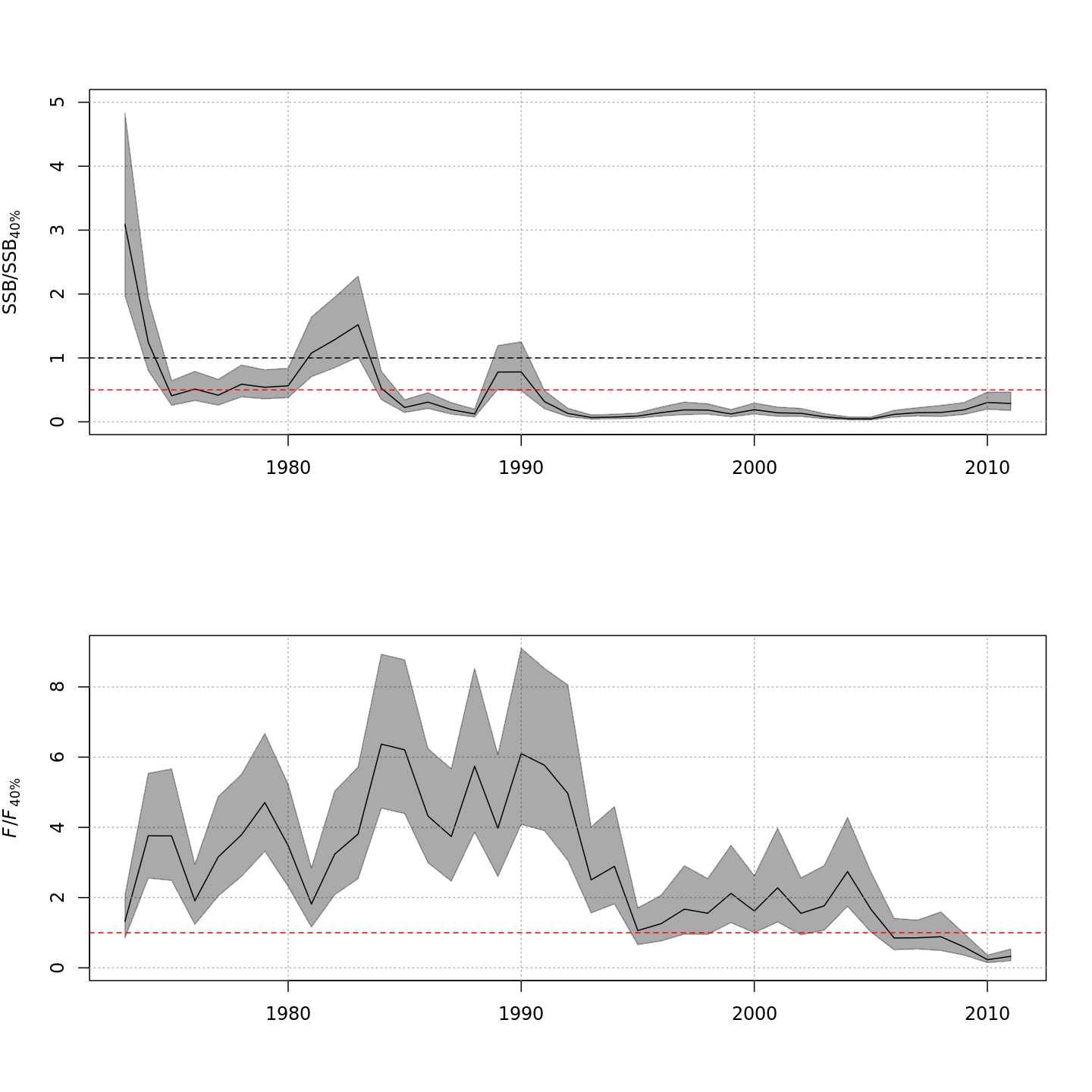
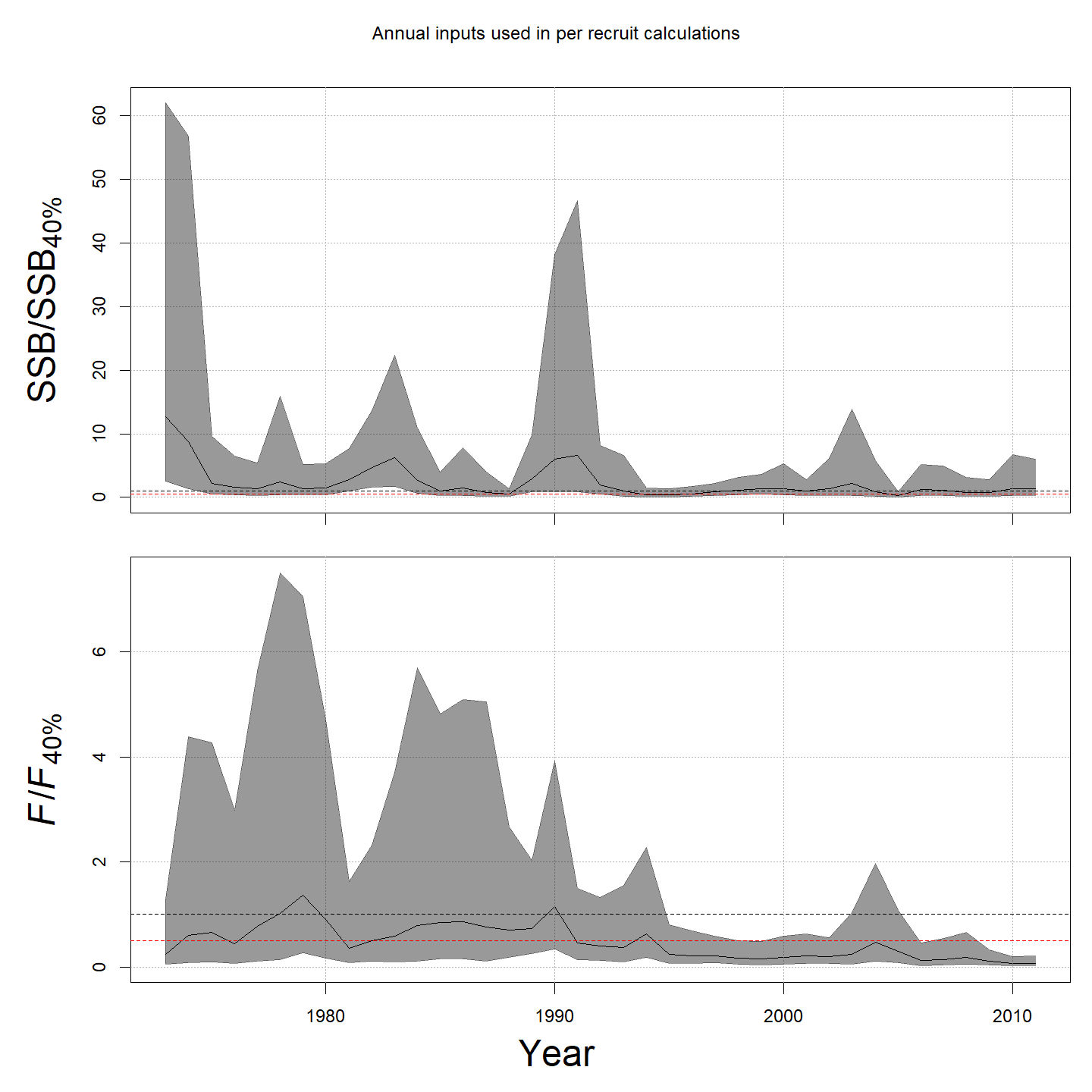
In the final year (2011), m12 estimated much lower
probabilities of the stock being overfished than m1 (1%
vs. 93%).
